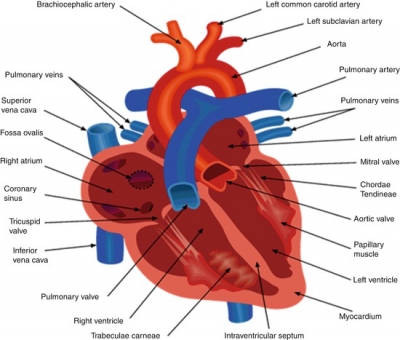
The heart is really two pumps in one, working in a continuous cycle. The right side pumps blood to the lungs, while the left side receives blood back from the lungs, then sends it round the rest of the body.
The heart pumps out about a cupful of blood about 70 times a minute, speeding up when necessary to meet body cells’ increased demand. Over a lifetime, the heart beats more than 2.5 billion times without resting.
Each side of the heart has a small upper space, called an atrium, and a larger space below called a ventricle. During each heartbeat, blood is pumped from atrium to ventricle, then out of the heart. Valves open and close to make sure that the blood only flows in one direction.
Aorta
The aorta is the first segment of the systemic arterial circulation, originating directly from the left ventricle of the heart. The aorta is the body’s largest artery.
Pulmonary artery
The pulmonary arteries and the pulmonary veins are the vessels of the pulmonary circulation; which means they are responsible for carrying the oxygenated blood to the heart from the lungs and carrying the deoxygenated blood from the heart to the lungs. This major blood vessel delivers oxygen-poor blood to the lungs.
Pulmonary veins
Oxygen-filled blood is carried from the lungs to the heart by these veins. here are 4 total pulmonary veins—with 2 pulmonary veins coming from each lung, left and right—that empty into the left atrium of the heart
Pulmonary valve
The pulmonic valve is one of two valves that allow blood to leave the heart via the arteries. This prevents blood flowing back into the right ventricle from the pulmonary artery.
Tricuspid valve
The tricuspid valve, or right atrioventricular valve, is on the right dorsal side of the mammalian heart, at the superior portion of the right ventricle. This controls blood flow on the right side of the heart.
Right atrium
The right atrium (RA) is one of the four chambers of the human heart, and is the first chamber to receive deoxygenated blood returning from the body. Oxygen-poor blood from the body flows into this chamber.
Left atrium
The left atrium is one of the four chambers of the heart, located on the left posterior side. Its primary roles are to act as a holding chamber for blood returning from the lungs and to act as a pump to transport blood to other areas of the heart. Oxygen-rich blood from the lungs flows into this space.
Mitral valve
This controls blood flow on the left side of the heart. The mitral valve and the tricuspid valve are known collectively as the atrioventricular valves because they lie between the atria and the ventricles of the heart.
Septum
The right and left sides of the heart are divided by this wall of muscle. Histological septa are seen throughout most tissues of the body, particularly where they are needed to stiffen soft cellular tissue, and they also provide planes of ingress for small blood vessels.
Left ventricle
The left ventricle is one of four chambers of the heart. It is located in the bottom left portion of the heart below the left atrium, separated by the mitral valve. Oxygen-rich blood travels from this chamber to the aorta.
Right ventricle
This chamber pumps oxygen-poor blood to the lungs. The right ventricle is one of the heart’s four chambers. It is located in the lower right portion of the heart below the right atrium and opposite the left ventricle.
Pericardium
The pericardium is a double-walled layer of tissue surrounding the heart. This tough, double-layered “bag” around the heart keeps infections out and stops the heart from expanding too much when blood flows into it.
Heartstrings
The heartstrings of the tricuspid valve sit between the right atrium and right ventricle. These tough cords stop the valves from turning inside out when the ventricles contract.
Picture Credit : Google



